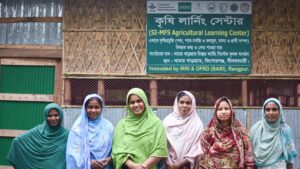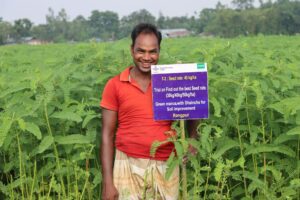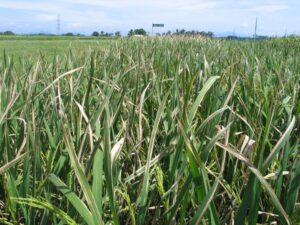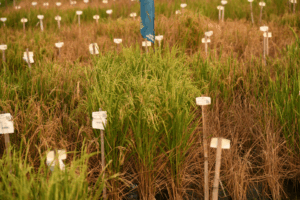A famine broke out in India’s northeastern state of Mizoram in 1958-59. It reportedly took more than 10,000 lives and caused severe sociopolitical conflicts. This led to the Mizoram Uprising in 1966, which was followed by a 20-year armed revolt against the central Indian authority. The struggle ended only in 1986 with the signing of a peace accord. What started the famine? The answer lies in the startling increase in rodent populations after the rare phenomenon of bamboo flowering occurred.
“Rodents are major pests in agricultural production,” says Grant Singleton, IRRI rodent expert and coordinator of the International Rice Research Institute’s (IRRI) Irrigated Rice Research Consortium. “In Asia, rodents cause, on average, annual preharvest losses of 5–10% in rice crops. A loss of 6% is substantial, as this is enough rice to feed 225 million people for a year. However, rare rat population outbreaks can cause severe crop losses, especially in the uplands, where such losses can lead to major food shortages.”
Since 2005, such cases have been reported in Mizoram (eastern India), Chittagong Hill Tracts (Bangladesh), Chin State (Myanmar), and the provinces of Oudomxay, Luang Namtha, Sayaboury, and Luang Prabang (Lao PDR). These infestations often happen after an expansive bamboo flowering takes place. Also known as mautam, rattadas, or nuu khii, this rare phenomenon occurs in the Bengal Bay ecoregion (India, Myanmar, Bangladesh), in northern Laos, and in other parts of the world where bamboo grows, including Peru and Argentina in South America.
Damage and disease in the Chittagong Hill Tracts
In November 2008, a team of researchers led by Dr. Steven Belmain, a rodent ecology and management expert from the Natural Resources Institute (NRI), University of Greenwich in the United Kingdom, submitted a scientific assessment report to the United Nations Development Programme on rodent outbreaks following bamboo flowering and their impact in the Chittagong Hill Tracts.
According to the findings, the dominant bamboo species in the region flower on a 40- to 50-year cycle. Rats devoured large quantities of bamboo seed, fueling their reproductive rate. As soon as they finished eating up the bamboo seed supply, they moved out into the agricultural fields and rural communities and searched for more food.
The damage these rats caused was far more serious than losing a few stored rice sacks. The communities suffered damage 4–5 times greater than that seen in the floodplains of Bangladesh. As if destroying nearly all field crops was not enough, the rats also invaded people’s houses, ate stored food, destroyed personal possessions, and even bit people while they slept.
Increased dysentery and cases of fever with unknown causes were also reported in the affected areas. Although it has not yet been clinically confirmed, these illnesses were believed to have been caused by rodent-borne diseases.
More rat outbreaks are expected to occur in many parts of the Hill Tracts in 2009 and 2010. To mitigate the damage, the NRI researchers proposed to the Bangladeshi government a strategy that includes community training and capacity building, ecosystem research, publicity, and an awareness campaign.
The worst rat outbreak in 20 years occurred in April 2008 in northern Laos. Farmers in the uplands lost most of their rice, maize, and other important cash crops. More than 500 villages with 250,000 people possibly affected turned to the World Food Programme (WFP) for assistance. The WFP then conducted an emergency food security assessment in March 2009 to measure the impact of the outbreak and the extent of the damage.
The study learned that nine districts across four provinces lost more than 50% of their expected harvest because of rat outbreaks, and other northern provinces were likely to be severely affected as well. In fact, 100% rice losses were common. Upland farmers in most areas believed that the outbreaks were due to bamboo flowering.
Moreover, rats brought food insecurity to 85,000–140,000 people and caused families to eat only one or two meals a day. The villages that suffered the most were the non-Lao Tai villages that relied mostly on upland farming, were far away from markets, had poor road access, had fewer labor opportunities, and had limited access to natural resources. The rat outbreaks came as an additional shock and an unwanted blow to their already challenged livelihood. According to the WFP’s assessment, food insecurity will even intensify when the 2009 rainy season sets in.
Invading Chin State in Myanmar
Chin State is located in western Myanmar, surrounded by the Chittagong Hill Tracts, and Mizoram. Like their neighboring countries, the people of Chin depend on upland rice cultivation for their daily calories. Unfortunately, they also share the problem of rising rat populations after bamboo flowering.
Nyo Me Htwe, a doctoral rodent ecology student and IRRI scholar, studied the impacts of rodent outbreaks throughout Chin State in 2007-08, which were believed to be the most serious in 50 years.
According to Ms. Htwe, rat outbreaks occurred in 30 villages in Paletwa, north of Chin State, in 2007. Caused by the Rattus rattus species, outbreaks erupted 2 months after bamboo flowering.
During the outbreak season, the extension staff from the Myanma Agriculture Service (MAS) conducted a rodent control campaign in 28 villages. Farmers used different ways to prevent further rat damage, such as setting local traps and driving them away with a barrage of noise.
“However, the farmers did not do them as a community, as it should be,” says Ms. Htwe. “They control rats by using different kinds of local traps only when they see damage in the field, and they rely mainly on rat hunters.”
According to MAS, Paletwa regularly imports 6,135 tons of rice from its neighboring district, Rakhine. In 2008, however, they needed to import about 1,200 tons more because of rat damage. The local government also arranged to buy surplus amounts of rice to sell to farmers at the base price, but most farmers did not have money to buy them.
Alarmingly, there were new reports in September 2009 of rodent outbreaks in Palatwa Township, Chin State, and Kyauktaw Township, northern Rakhine State (Arakan). MAS said that rodent damage to upland rice started in August 2009 following massive bamboo flowering, similar to the 2007 and 2008 occurrences.
Working and learning together
Rodent outbreaks are not confined to the upland regions. This year, high crop losses because of rats were also reported in the Philippines and Southeast Sulawesi, Indonesia. These, however, were not related to bamboo flowering but to the asynchrony of rice planting in the irrigated lowlands. Such patchy outbreaks occur too often in the intensive lowland rice agroecosystems.
Unfortunately, there is little documentation of the factors leading to these outbreaks, their impacts, and the successes and failures of management action.
IRRI believes it crucial to conduct an international conference on the impacts of rodent outbreaks on food security in Asia. Scheduled for 26-28 October, the conference will document the evidence and impact of rodent infestations and to develop a framework for research on rodent management in the agricultural systems of Asia. Participants will review the impact of ecologically based rodent management in both lowland and upland rice environments in Southeast Asia and develop follow-up activities that include forging partnerships with the public and private sector (e.g., civil society groups and nongovernment organizations).
Plenary presenters will include Dr. Belmain, Ms. Htwe, Dr. Singleton, Dr. Ken Aplin (Mizoram), Dr. Bounneung Douangboupha (Laos), and Dr. Sudarmaji Indonesia).
“Historically, there are records dating back to the 1750s of these rodent explosions that have led to devastating food shortages in eastern India, western Myanmar, and southeastern Bangladesh,” says Dr. Singleton. “However, there is little information documented about what species are involved, what methods proved effective in holding the hordes of rats at bay, or when these outbreaks will happen.”
What has surprised the rodent experts is that, over the past 4 years, the outbreaks have been blinking in and blinking out.
“It is not just one tidal wave of rodents. Instead, it is a gradual wave sweeping through the region, he said. “There is so much we need to share and document so that we can be better prepared in the future to fight these waves of starvation.”









